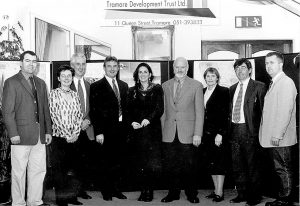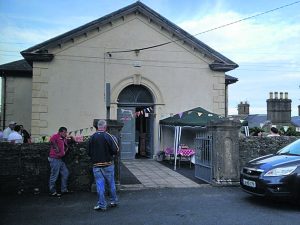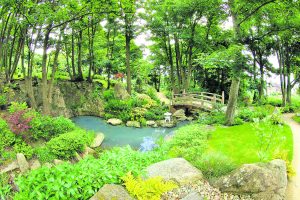
Tramore Development Trust has played a pivotal role in the rejuvenation of the seaside town
Kieran Foley
A recent episode of RTÉ’s ‘Nationwide’ which focused on Tramore attracted many plaudits locally. The programme featured the fantastic work of an eclectic mixture of groups operating within Tramore and provided a wonderful snapshot of a town which has transformed its image. One of the groups instrumental in this rejuvenation is the Tramore Development Trust.
This community led voluntary organisation was established in 2000 and is a company limited by guarantee with charitable status. The group consists of passionate and driven individuals who utilise their skills and expertise in various fields to work collaboratively for the overall good of the town and its population. Their mission statement outlines the Trust’s aim to “foster a vibrant heart within Tramore by encouraging social integration and by harnessing our resources, our people and our unique natural environment”.
Among their key objectives is to bring functionality and sustainability to buildings which are no longer in use. Reflecting on the past 20 years, Chairperson Anne Harpur recalled the origins of the Trust.
“It was evident that the lifeblood of the town was being sucked out of the centre towards Waterford,” she explains. “That often happens with a satellite town which is very close to a city, it’s only natural. It’s not Waterford’s fault but it’s a dynamic which occurs and it presents a dilemma.”
At the time, even though Tramore had numerous community groups, there was no distinct group which was specifically focused on the core of the town and its future needs.
Born and raised in Tramore, Anne has always been passionate about the area. After moving back from Dublin in 1999, she wanted to contribute to the betterment of the town. Along with fellow architect Dave Smith and artist John O’Connor they decided to take matters into their own hands and formed ArcArt which aimed to examine the town’s potential, focusing specifically on the town centre.

The founding board of Tramore Development Trust pictured in May 2001. L-R: Paul Jackman,
Bridget Power, David Smyth, John Smiles, Anne Harpur, Joe Stokes, Sandra Thompson, Eamonn McSweeney and Brian Nolan.
“If we could get the heart of the town throbbing again, we felt it would create vibrancy around the entire town,” she explains. A public meeting was held in which slideshows were displayed showing the town as it currently looked and how it might appear in the future. Anne says there was a hugely positive reaction to this public meeting and it was from this initial event that the first Community Trust in Ireland emerged.
“We were very much aware that we didn’t have a mandate to go off and do what we thought was right,” says Anne. “We needed participation. We had a vision but we set up workshops in which we asked groups to participate and give their input.”
Based on Scottish community development examples, and with the assistance of a community development advisor from Scotland who was in Ireland at the time and offered to assist, Tramore Development Trust created an ambitious community plan. Every home in the town received a copy of this plan and the Trust invited feedback.
“It was essential that we got feedback from the people who live here because they know the area best,” says Anne. This community plan has served as the Trust’s Bible and members have repeatedly returned to it in order to ensure they remain on the right path. Another of the Trust’s initial tasks was to embark on an audit of the town’s building stock to identify vacant buildings.
“We matched what was needed against what was available,” explains Anne. “There was no point in building from scratch when we have fantastic buildings. We examined the needs of young people and older people; the community facilities which were missing; the environmental needs of the town; all of these strategic aims.”
Coastguard Centre
The first major project which the Trust embarked on was the redevelopment of the town’s Coastguard Centre. At the time, there was no cultural or community centre in the town. Today, the Tramore Coastguard Cultural Centre is the Trust’s flagship project and testament to its success. The building, which boasts enviable panoramic views, originally served as Tramore Coastguard Station from 1874 to 1922. It was home to Tramore Garda Station from 1924 to 1988. Unoccupied throughout the nineties, it was badly damaged in a fire in 2000.
In 2002, the Office of Public Works (OPW) commenced work to restore and preserve the property. Every effort was made to retain the architectural and historical integrity of the building and it was officially opened in 2004. The aim of the Coastguard Cultural Centre is to develop art, culture, and heritage for the community of Tramore and the surrounding areas. Prior to Covid-19, this multi-purpose community facility was a hub of activity with regular exhibitions being held in its impressive upstairs art gallery. This space was also used for art classes, yoga, children’s activities, book launches, intimate musical sessions, and many other activities. Downstairs, the Coastguard Cultural Centre’s café has garnered a well-earned reputation for a mouth-watering array of treats.

Tramore Coastguard Cultural Centre which is the flagship project of Tramore Development Trust.
Despite the severe curtailment of activities due to the pandemic, the Centre continues to play an important social role. During the first lockdown, many people sorely missed their regular visits to the Centre and particularly to the café. Throughout the country’s second lockdown, and now our third lockdown, a takeaway service has continued to operate through a hatch at the Centre overlooking Tramore Bay.
Anne believes it’s important to “keep the flag flying” and to retain a close connection with all who enjoy using the building. In December, a popular addition to the garden was the Star of Hope installation which remains in place.
“The star represents 20 years of the Trust but it’s also a powerful symbol during a really difficult time,” explains Anne. “We were conscious of our diaspora who couldn’t come home for Christmas so we wanted to send a light across the bay to connect with them.” The Star of Hope is illuminated each evening and will remain in place throughout the current lockdown. The star has provided solace during a particularly turbulent time for Tramore which saw a huge spike in Covid-19 cases.

The Star of Hope located on the grounds of the Coastguard Cultural Centre.
Meeting Place
Following the Trust’s success with the Coastguard Centre, members were contacted by the Society of Friends with a proposition for their Meeting Place on Upper Branch Road which wasn’t being utilised. This marked the beginning of a close relationship with the Quakers.
The Trust identified that there was a need for an after-school centre in the town and the Meeting Place building was refurbished and equipped to facilitate such a service. A garden was developed in which children could grow their own vegetables. The Tramore Development Trust Director who led the project at The Meeting Place was Sandra Thompson.
Disappointingly, government funding for this worthwhile project ceased and the service ended. The building was vacant for a number of years during which members of the Trust were approached by different groups with various ideas for its future use. However, Anne explains that all involved with the Trust were keen to select a project which closely reflected the ethos of the Friends and which matched the special atmosphere of the building.

Chair of Tramore Development Trust Anne Harpur.
“It has been a place of great good and there is a wonderful sense of peace and serenity,” she explains. “After so many years of good work we wanted the building to serve a similar purpose. Instinctively we knew we needed to find a special use.”
In what could be described as serendipity, the Brothers of Charity were seeking to develop a centre which would play host to a project allowing adults with special needs to further integrate into the wider community.
“It was absolutely perfect,” says Anne. Under the guidance of Hilary Deeley, service users at the Meeting Place have connected with other projects and some have taken on jobs at the café within the Coastguard Cultural Centre which has helped build confidence and independence.
As the Trust didn’t want to lose the building’s historical connections, they asked if the Society of Friends would like to hold a meeting in the building once a year. This stipulation has now been included as part of the building’s lease agreement to ensure that this tradition can continue into the future.

The Brothers of Charity operate a centre for adults with special needs at the Meeting Place.
Japanese Gardens and other projects
Another hugely successful addition to Tramore in recent years has been the Lafcadio Hearn Japanese Gardens on Pond Road. Tramore Development Trust played a pivotal role in bringing this ambitious idea, which was led by Agnes Aylward, to fruition.
Officially opened in 2015, the magnificent gardens were created through close collaboration between expert gardeners and a team of trainees who gained invaluable experience while working on the project. The gardens pay homage to Patrick Lafcadio Hearn who spent his childhood summers in Tramore and attained literary fame in Japan.
The amenity has served to diversify Tramore’s tourism offering and has proved hugely popular amongst locals, including at Christmas during the impressive Enchanted Garden lights display.
Throughout its 20 years, members of Tramore Development Trust have diligently worked on other smaller projects, from staging trade shows to organising sand sculpting competitions. The Trust helped establish Tramore Chamber of Commerce which is now part of Waterford Chamber. Members also assisted in the development of Klub Muzik, a centre for children to learn music based in Riverstown.

The Lafcadio Hearn Japanese Gardens were officially opened in 2015.
Research entitled ‘Understanding the Needs and Lifestyles of our Elderly’, published in 2005, was the catalyst for the establishment of Tramore Voluntary Housing Association, which is advancing a sheltered housing project for older people in Ballycarnane.
Various environmental projects have been embarked upon over the years, including the establishment of different walking routes within the local area. Tramore Development Trust has also recently designed a Tranquility Trail for Tramore, which is based on specialist Environmental Acoustic research by Bradford University UK, in collaboration with WIT.
As a result of the successful heritage regeneration projects initiated and carried out by Tramore Development Trust, The Heritage Council of Ireland funded research into the impact of these projects on the fabric and community life of Tramore. This research led to the report ‘Community & Cultural Heritage; An Exploration of Identity, Purpose & Meaning’. Following on from this research, during the European Year of Heritage in 2018, Tramore was chosen, together with four other towns, by The Heritage Council as an exemplar for community-led heritage regeneration of smaller towns in Ireland. Tramore is featured in The Heritage Council’s publication ‘Ballybrilliant; Heritage led Regeneration in 5 Irish Towns’.
Pride of place
Reflecting on all that has been achieved throughout the past 20 years, Anne says there is a sense of satisfaction but adds that there is also an awareness of the need for further work.
“We’re constantly thinking about what else can be done. There’s great potential,” she says.
The current nine member board of the Trust is a fusion of original members and new blood. The Trust has continued to work closely with various partners, including Waterford City & County Council.
Anne praised the “extraordinary work” of her fellow board members, and their “selfless dedication and commitment”, describing them as “very modest”. She adds that many others in Tramore have been quietly supporting the Trust in their own individual ways.
She notes the pride of place which is now clearly evident amongst all who are fortunate to call Tramore home. She also believes that the Covid-19 pandemic presents an unprecedented opportunity for locations such as Tramore as many people re-evaluate their work-life balance and seek to escape cities. Possessing a successful commercial sector, impressive recreational facilities, numerous sporting and community groups, and one of the fastest growing populations in the country, Anne believes there is potential for Tramore to become a dynamic, enterprising and creative hub in which people can “live, work and have a really exciting leisure life”.
She says high-profile features on Tramore, such as the recent ‘Nationwide’ programme, have reaffirmed the town’s identity and “revealed our secret beauty and offerings” to a wider audience.
In addition to being passionate about Tramore, Anne is also hugely invested in the concept of community development.
“It grounds you,” she says. “Your mission is to serve the community and it’s incumbent on you to tap into that community, hear people’s voices and involve them.”
It’s clear that members of Tramore Development Trust have certainly served their community exceptionally well throughout the past 20 years. With such inspirational community leaders and visionaries, Tramore can certainly look forward to many brighter days ahead.

